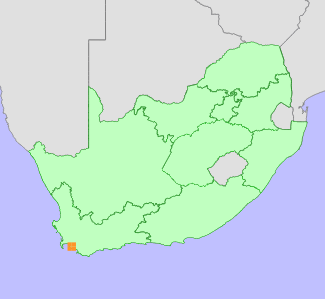|
Scientific Name | Serruria flagellifolia Salisb. ex Knight |
Higher Classification | Dicotyledons |
Family | PROTEACEAE |
Common Names | Houwhoek Spiderhead (e) |
National Status |
Status and Criteria | Vulnerable B1ab(ii,iii,iv,v)+2ab(ii,iii,iv,v) |
Assessment Date | 2020/06/28 |
Assessor(s) | A.G. Rebelo, H. Mtshali & L. von Staden |
Justification | Serruria flagellifolia has a restricted distribution range, with an extent of occurrence (EOO) of 414 km², and an area of occupancy (AOO) of 116-120 km². Ten known locations continue to decline due to agriculture, too frequent fires, competition from alien invasive plants, and mining. Therefore it is assessed as Vulnerable under criterion B. |
Distribution |
Endemism | South African endemic |
Provincial distribution | Western Cape |
Range | This species has a very limited distribution in the mountains of the Western Cape Province, South Africa, where is occurs in the Kogelberg, Groenland and Babilonstoring mountains. |
Habitat and Ecology |
Major system | Terrestrial |
Major habitats | Overberg Sandstone Fynbos, Kogelberg Sandstone Fynbos, Elim Ferricrete Fynbos |
Description | It grows in sandstone fynbos at lower altitudes, 50-600 m. Mature individuals are killed by fires, and only seeds survive. Seeds are released after ripening, and dispersed by ants to their underground nests, where they are protected from predation and fire. It is pollinated by insects. |
Threats |
| This species has lost habitat to vineyards, wheat and protea orchards in Leeu and Bot river valleys and to pine plantations across its range in the past. Current threats to this species include competition from alien invasive plants (acacias and hakeas), and too frequent fires, as local extinctions can occur when fires repeatedly kill individuals before they reach reproductive maturity. Other threats include sand mining in some parts of the habitat. |
Population |
It is known from a 24 km long area, with 20 subpopulations occurring at 10 locations. It occurs in dense, isolated colonies. The population continues to decline due to habitat loss and degradation.
|
Population trend | Decreasing |
Conservation |
| It is found within the Kogelberg and Houwhoek nature reserves. |
Assessment History |
Taxon assessed |
Status and Criteria |
Citation/Red List version | | Serruria flagellifolia Salisb. ex Knight | VU A4c; B1ab(i,ii,iii,iv,v)+2ab(i,ii,iii,iv,v) | Raimondo et al. (2009) | | Serruria flagellifolia Salisb. ex Knight | Rare | Hilton-Taylor (1996) | |
Bibliography |
Goldblatt, P. and Manning, J.C. 2000. Cape Plants: A conspectus of the Cape Flora of South Africa. Strelitzia 9. National Botanical Institute, Cape Town.
Hilton-Taylor, C. 1996. Red data list of southern African plants. Strelitzia 4. South African National Botanical Institute, Pretoria.
Raimondo, D., von Staden, L., Foden, W., Victor, J.E., Helme, N.A., Turner, R.C., Kamundi, D.A. and Manyama, P.A. 2009. Red List of South African Plants. Strelitzia 25. South African National Biodiversity Institute, Pretoria.
Rebelo, T. 2001. Sasol Proteas: A field guide to the proteas of southern Africa. (2nd ed.). Fernwood Press, Vlaeberg, Cape Town.
|
Citation |
| Rebelo, A.G., Mtshali, H. & von Staden, L. 2020. Serruria flagellifolia Salisb. ex Knight. National Assessment: Red List of South African Plants version . Accessed on 2025/09/03 |
 Comment on this assessment
Comment on this assessment

